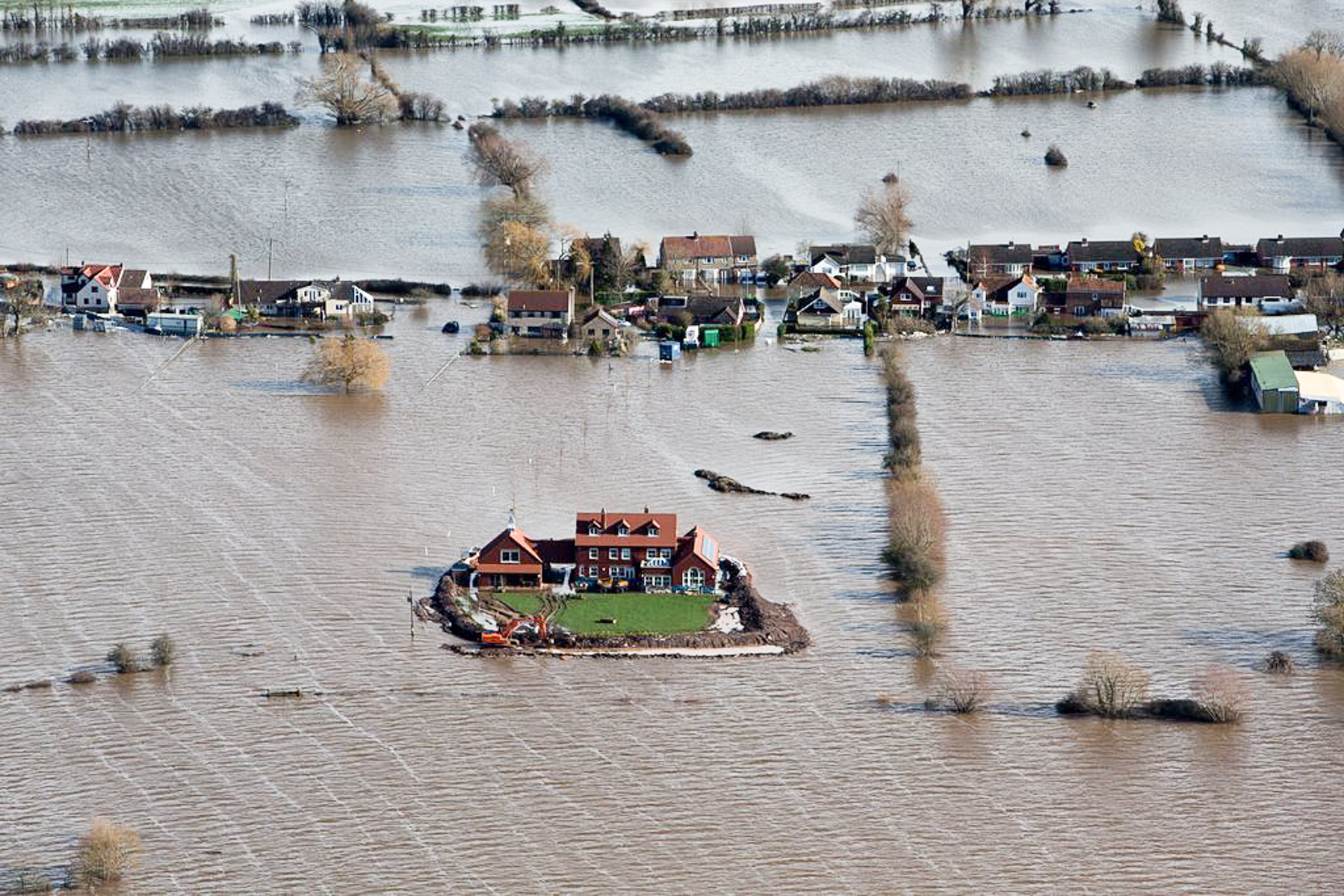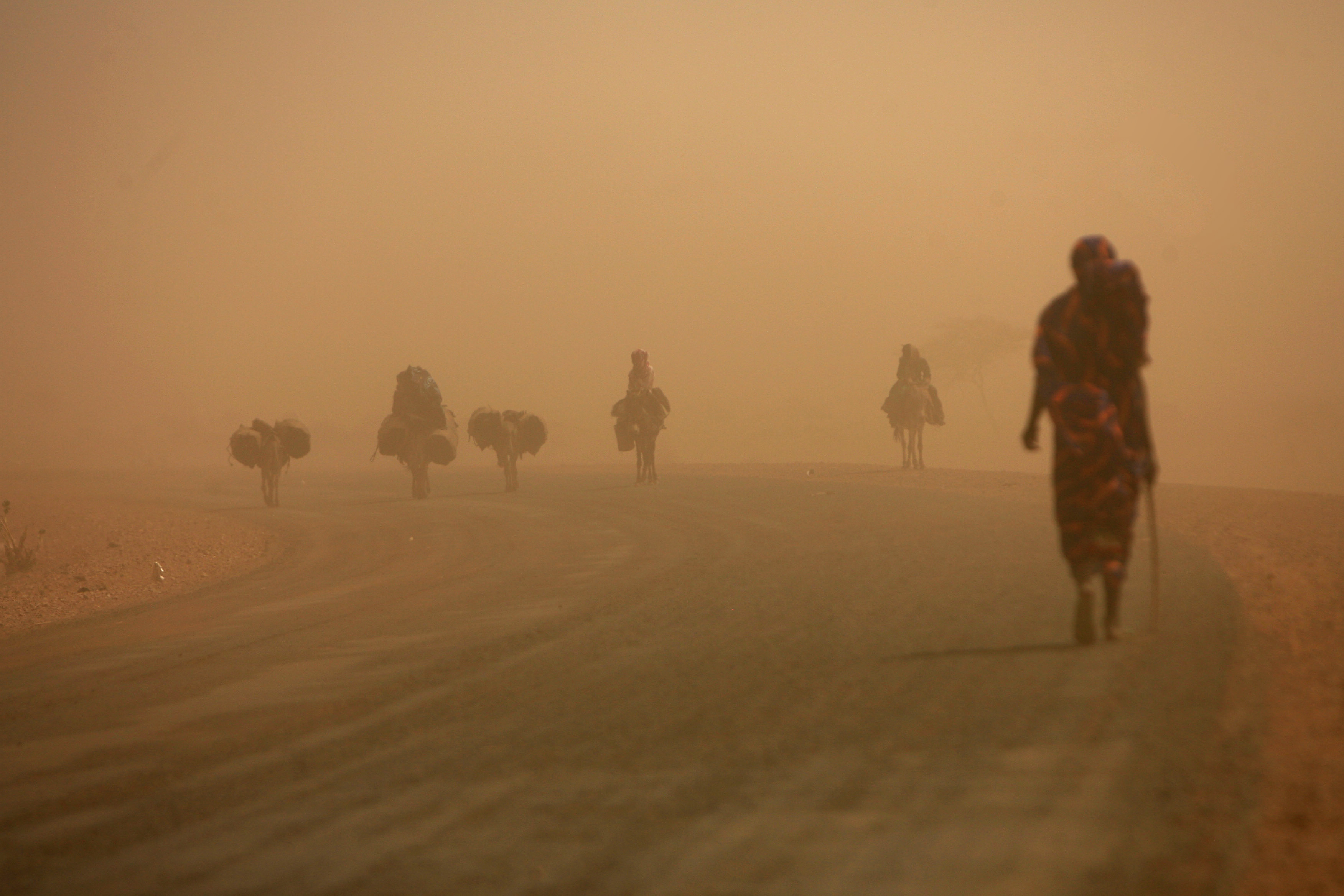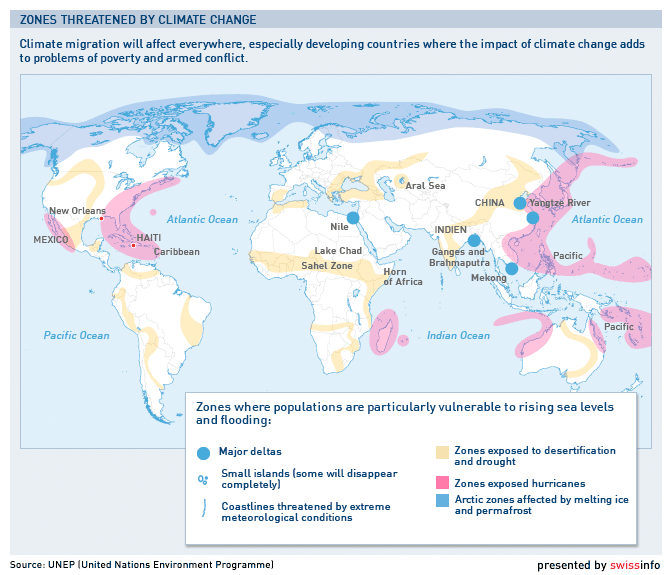
‘Climate migration also concerns rich countries’

One of the most important issues in a new report by the Intergovernmental Panel on Climate Change (IPCC) is the impact on migration flows – a phenomenon not limited to the world’s poorest regions, warns a Swiss migration expert.
Thousands of Americans, fleeing the intense cold, are seeking refuge in Mexico. OK, that’s science-fiction, but the scene from 2004 Hollywood blockbuster The Day After Tomorrow illustrates a very real issue: climate migration.
By 2100, hundreds of millions of people will have abandoned coastal zones as a result of rising sea levels, highlights the IPCC in the report to be published on Monday.
Etienne Piguet, a professor at the University of Neuchâtel, tells swissinfo.ch that the impact of the climate on population behaviour is well known. But his latest research has produced surprising – and paradoxical – results.
In 2012, natural disasters forced 32.4 million people to leave their homes.
98% of these displacements were caused by climate and meteorological events such as floods, storms and fires.
The most affected countries were China, India, Pakistan, the Philippines and Nigeria.
In northeastern India alone, repeated floods during the monsoon season caused 6.9 million evacuees (almost the entire population of Switzerland).
In the United States, almost 800,000 people had to flee from Hurricane Sandy.
(Source: “Global Estimates 2012”, a report by the Norwegian Refugee Council’s Internal Displacement Monitoring Centre)
swissinfo.ch: One tends to think that climate migration is a relatively recent phenomenon. Is it?
Etienne Piguet: Since 2007, when the IPCC published its fourth assessment report, we have witnessed a sort of revival in the notion of climate migration. In reality the idea’s been around for ages. The “dust bowl” of the 1930s comes to mind: dust storms and wind erosion of the soil forced many farmers on the Great Plains to move to California.
Going back further, there’s the Irish potato famine [in the 1840s], which encouraged migration to the US. Sure, the cause was the blight that affected the harvest, but this was in turn promoted by the climate and the succession of very wet and humid seasons.
swissinfo.ch: So climate is a driving force of migration?
E.P.: Yes and no. Unlike in the past, today the climate is considered one of many factors which influence migration. The dust bowl occurred after the economic crash of 1929, which had already made the situation precarious for farmers. Also in Ireland British policy encouraged people to leave. So in addition to the climate, there are also political, social and economic factors.
Studies show a strong impact of the temperature and of periods of drought on agricultural productivity. There are two reasons: some plants are less productive than others, and above a certain temperature physical labour becomes difficult. Populations are therefore vulnerable. But will they really emigrate? Hard to say. If their governments help them change economic activity, maybe they will stay where they are.
Think of the Netherlands and the rising sea level – had the government not had the resources to build dykes, people would have been forced to leave.

More
Fleeing from natural catastrophes
swissinfo.ch: When one talks of climate migration, one automatically thinks of the poorest countries. A justified association?
E.P.: Poor countries have greater difficulty, for technical and political reasons, coping with the challenges created by climate change. But our most recent study revealed, slightly surprisingly, that migration also concerns the richest countries.
In terms of the population, it’s these countries that are really in the front line. Just think of China and the millions of people who live along the coast. Furthermore, a few catastrophes – either sudden or sustained – together with changes in economic activity could generate significant movements in Europe and North America, as we saw with Hurricane Katrina in 2005.

I want to emphasise a crucial aspect. We have established that the zones under greatest threat, for example from rising water levels, are also those which are booming demographically. Despite their vulnerability, coastal cities in China and Africa continue to attract more and more people. It’s a paradoxical and potentially explosive situation.
The migrants are often aware of the danger, but they have different time frames. Their strategy is to survive and feed their families today. They don’t consider the risk that, tomorrow, the waterway on which they have settled could flood because of a hurricane.
swissinfo.ch: And Switzerland? According to one study, entire alpine valleys risk becoming uninhabitable because of melting permafrost and landslides.
E.P.: Switzerland, like other developed countries, is not sheltered from the economic and social consequences of climate change. In any event the country will not be confronted with waves of climate migrants.
Some alpine valleys are very vulnerable and could become uninhabitable. But we’re talking of a few hundred people. Sure, for the people who live there it’s dramatic, but we have to put things in perspective: we can’t compare the situation in Switzerland with that of a province in Bangladesh where 95% of the population, who live from agriculture, are exposed to the risk of increasingly common periods of drought.
swissinfo.ch: In future it will be necessary to define the statute given to those fleeing their homes owing to the climate. Will we soon have ‘climate refugees’?
E.P.: It’s a much-debated issue. There are basically three schools of thought: one says that it’s necessary to create a new convention specifically to protect people who have to relocate in cases of environmental catastrophe and gradual environmental changes.
Then there are those who would like to expand the existing definition and include climate-related reasons in the refugee convention. This is already the case to a small extent regarding the convention of the Organisation of African Unity, where the concept of refugee incorporates environmental catastrophes.
The third option is to improve the capability of humanitarian aid, to work on prevention and to insist on solidarity mechanisms in the zones most at risk.
What is certain is that many, many people will be unable to flee from catastrophes. Only people who are healthy and have financial resources are able to flee. The immobile population on the other hand risk finding themselves in a humanitarian situation even worse than those who emigrate.
The Intergovernmental Panel on Climate Change’s Fifth Assessment Report, produced by the IPCC’s Working Group II, deals with impacts, adaptation, and vulnerability. It is part two of a four-part assessment. The first part, by Working Group I, dealing with the physical science basis of climate change, was finalised in September 2013. The Working Group III contribution, assessing mitigation of climate change, will be finalised in April. The Fifth Assessment Report will be completed by a Synthesis Report in October.
The second report, published on March 31, warned that meteorological extremes will compromise the biodiversity of plants and animals and drastically reduce agricultural yields.
In addition, the risk of flooding will increase, above all in Europe and Asia, while one of the most marked consequences of warming in Africa will be access to water. Floods in coastal areas, droughts and heatwaves will lead to greater population movements and, indirectly, to increased risk of violent conflicts.
The IPCC is the international body for assessing the science related to climate change. It was set up in 1988 by the World Meteorological Organization and the United Nations Environment Programme to provide policymakers with regular assessments of the scientific basis of climate change, its impacts and future risks, and options for adaptation and mitigation.
(Translated from Italian by Thomas Stephens)

In compliance with the JTI standards
More: SWI swissinfo.ch certified by the Journalism Trust Initiative































You can find an overview of ongoing debates with our journalists here . Please join us!
If you want to start a conversation about a topic raised in this article or want to report factual errors, email us at english@swissinfo.ch.